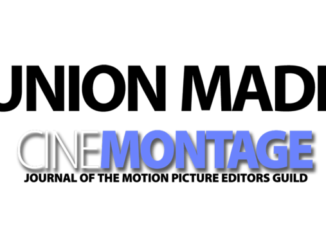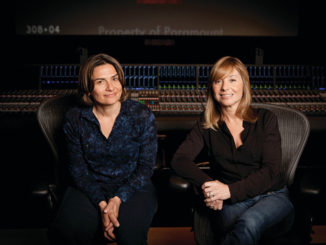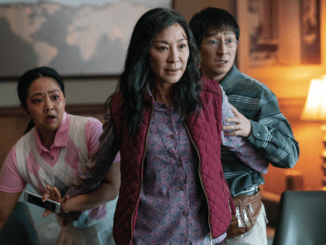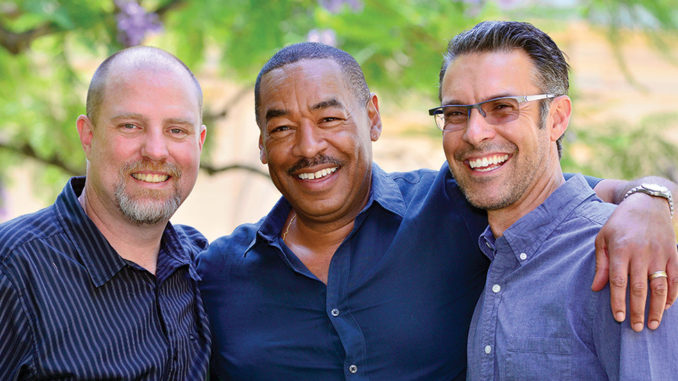
by Mel Lambert • portraits by Martin Cohen
The world of episodic TV and cable has been experiencing some major challenges during recent seasons. As appointment viewing transitions to more on-demand streaming and even binge-watching, there is a pressing need to deliver increasingly innovative and enveloping soundtracks for a wider range of offerings.
Rarely is that diversity more evident than in the post-production schedule faced on a regular basis by the creative trio of supervising sound editor Gary Megregian, MPSE, dialogue/music re-recording mixer Joe Earle, CAS, MPSE (himself a former sound editor), and sound effects re-recording mixer Doug Andham, CAS. All three work regularly on several series: 9-1-1 (2018-present; this procedural drama featuring first responders has its second season premiere September 23 on Fox), American Horror Story (2011-present; the eighth season of this multiple-award-winning show returns September 12 on FX), American Crime Story (2016-present; Season 3 is due early next year) and Pose (2018-present; this new dance musical exploring the juxtaposition of several segments of life and society in New York ended its first season in July and will return for a second season in January 2019). All four shows are produced by Fox Television or FX Productions. Earle and Andham are based on Stage 3 at Technicolor Sound at Paramount in Hollywood (which recently announced it is abandoning fearture work to concentrate exclusively on episodic series and streaming content).
In terms of developing sound signatures for each of these very different TV series, Megregian reveals that the post team’s learning curve was relatively shallow because “[writer-producer] Ryan Murphy is the showrunner for all of these shows — and many of his executive producers work on more than one show.” He continues: “However, the one common executive producer with whom we work the closest is Alexis Martin Woodall.” Woodall communicates Murphy’s vision for each project and oversees the final mixes, according to the supervising sound editor, who adds, “I usually have a conversation with Alexis at the beginning of each season to discuss the tone and specifics of what they’re looking for in the show’s soundscape, and then check in with her from time to time throughout the season.”
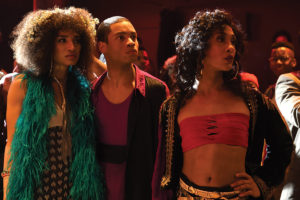
Pose – Don’t Turn Down the Music
While the musical content for Pose plays a large role in the show’s storytelling, “Alexis and I discussed early on what role crowds would play in the ballroom sequences, for both sound effects and Loop Group,” Megregian recalls. “It was very important to Alexis that we had the right casting for Loop Group, leaning heavily on African-American and Latino voices.”
“Many times I have said on the stage, ‘There’s room for everything’,” relates Earle. “If there is an element of the scene we want to hear, it is up to Doug and me as mixers to clear whatever may be masking that particular event. Sometimes we want to hear a vocal, a footstep, a production ‘clunk’ or an element in the backgrounds. On Pose, we have loud cheering, specific group call-outs for on-screen extras, cloth flaps, clicky high heels, an incessant MC and, on top of it all, railing dance music. The last thing to lower is the music! Little fader moves, a bit of compression or even a momentary dent with EQ can clear enough room for the particular event and still not feel like we’ve lowered the overall energy.”
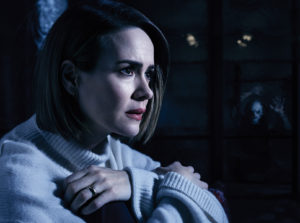
American Horror Story – Creating Unease
In contrast, American Horror Story poses its own unique challenges, since each season is conceived as a self-contained miniseries with some plot elements being loosely inspired by true events. “The fun thing about American Horror Story is that each season is like starting a brand new show,” Megregian offers. “While there are similar sonic elements between seasons, each season requires its own fresh palette of sounds.”
“Yes, each season of American Horror Story presents a different scenario,” agrees Earle. “We also venture into different time periods within each season. In those cases, it may be the music that connotes the time change — but more often it is done with sound. Gary, Doug and I are very aware of putting something iconic and organic in the soundscape to clue in an audience.”
Adds Andham: “Season 1 took place in a haunted house, and we used various tonal ambiences to create a sense of dread. Season 2 takes place in an asylum, so Joe and I made use of the 5.1 environment by placing screams, moans and great group ADR all around the viewer, constantly changing placement and reverb to generate unease. We create an eeriness by placing moments of silence before moments of violence so they have more impact.”
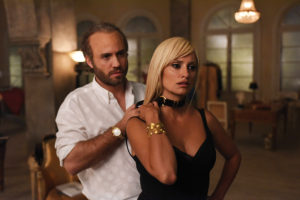
American Crime Story – Varying Soundscapes
American Crime Story has a similar structure to AHS, but focuses on real-world events. “Sound-wise, Season 1, The People vs. O.J. Simpson, and Season 2, The Assassination of Gianni Versace, were quite different,” Megregian points out. “O.J.’s soundscape had a range from the cityscape of 1990s Los Angeles: the chaos of protests outside the courthouse to the almost isolating quiet inside.” Interjects Earle, “That show gave us the opportunity to have full environments, like the DA’s offices and on-street demonstrations juxtaposed with the quiet chamber of the courtroom. The great production recordings allowed for an eerie hush when we most needed it.”
“During the first episode of The People vs. O.J. Simpson, we started very stark and quiet, showing video footage of the Rodney King beating that led to the LA riots,” explains Andham. “The soundtrack builds to a crescendo full of crowds, sirens, breaking glass, fire and explosions as it shows the riots, before going to black. Then we start quietly again doing a ‘slow burn’ — Joe’s expression — as we follow the discovery of the victims and the aftermath of the growing media circus, with the soundtrack getting busier and more frenetic as the activity increases.”
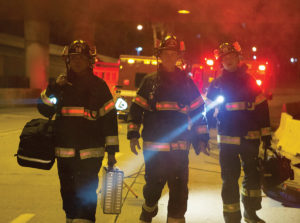
9-1-1 – An Athletic Exercise
The show 9-1-1 is pure adrenaline, according to Andham. “Ryan Murphy reinvented the procedural with this series,” he says. “Every episode is chock-full of crazy events ripped from the headlines and told in a high-gloss, high-energy manner; the soundtrack has to support that with effects and design. The mix is very full and loud — and very layered.”
Earle considers this show to be an athletic exercise. “The characters barely have time to stop and breathe before they are on to the next action sequence,” he says. “From high-elevation roller coaster rescues to a sinking jetliner, we’ve mixed it all! Gary and his crew of experienced editors give us the right material with which to work. For dialogue, I cannot waste time auditioning whether the boom or the lavaliere microphone sounds better for a particular scene; the editors have to make that choice, and we go! The point is to get to the end and then shape or fix whatever we didn’t fix in the first pass.”
Keeping Track of the Shows
A major commitment for Megregian is to keep all the shows on track. “Because we often have more than one show dubbing and airing at the same time, we’re constantly up against air dates,” he explains. “Since Joe and Doug are mixing all of these shows, oftentimes we need to shift mixes around when one episode may be running behind schedule for any number of reasons. We have the flexibility of jumping ahead to get an earlier start on mixing another show because it was turned over earlier, and we’re ahead of it even though the mix might have been scheduled later.”
Each show has a dedicated dialogue and lead effects editor, Megregian reveals. For O.J., Jason Krane, MPSE, handles dialogue editing, while for American Horror Story, Versace and Pose, Megregian uses Steve Stuhr, and for 9-1-1, it’s Lance Wiseman. Tim Cleveland edits effects for American Horror Story and John Snider does the same for American Crime Story — both O.J. and Versace — as well as Pose, while Danny Salas handles 9-1-1.
First Pass During Re-Recording
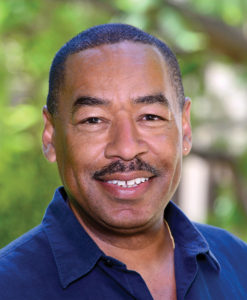
Whenever Earle does an initial dialogue pass, he always listens for a common timbre in the voices. “I then proceed to pre-dub the dialogue, choosing to match timbre and level first,” he says. “Consistency and clarity between lines is far more important than whether or not the take is dirty or clean. I then wait and let Doug fill up the scene with backgrounds and hard effects.”
As Earle works through a scene, Megregian will listen to areas with which the dialogue/music mixer may be struggling and can make adjustments as he works. “Usually, by the time I’m finished with a scene,” Earle adds, “Gary has already fixed the sync issue or the down-cut word and the tick at the end of a line. We simply swap out his fix, and the scene plays flawlessly.”
“After Joe has taken his dialogue and music pass at an act, I’ll have a level to mix against,” Andham follows. “Then I’ll take an effects pass and pre-dub against his work, listening to each of my sounds, equalizing and doing whatever panning is necessary. I like to mix the backgrounds first in solo so that I hear what I have, and then play it against Joe’s dialogue to help create the sound of the world where his dialogue will live. Next, I work on the hard effects against the backgrounds, dialogue and music so that we can be close to what we want to present. I add the Foley last, using it to supplement and enhance the production sound and hard effects.”
Picture and story always inform their mixing choices, Andham emphasizes. “Our shows definitely have their own sound, but we tend to find those organically with each series,” he adds. “Gary and his team of editors do a great job of giving many different options with ambiences and backgrounds, along with multiple kinds of spotted sound effects that I can spread around the room or used to help flesh out the world with movement and life.”
Streamlining the Mix Process
Andham has a sound effects template that he uses for every show. “It is built in such a way as to allow us some flexibility when moving between different series,” he explains. “We need to work very fast and be flexible, so Gary and his team use my template to build each show. There are defined tracks for backgrounds, sound effects and Foley, which are routed to channels on the console that I already have bussed to the various stems I am creating. The sound editors try to cut the sounds we use often on the same tracks — doors are usually on the first three channels, for example. Depending on what the picture requires, they cut multiple options for some sounds, such as gunshots and fight sounds with different frequency characteristics, which allows me to mix them as I see fit, maybe adding some low end to the sub.”
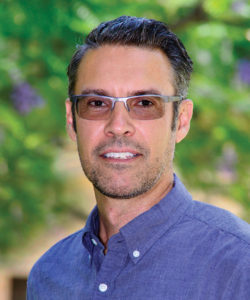
Andham will inform Megregian how certain sound effects are working to help him determine whether some should be replaced or enhanced. “Gary will also cut things for me on the stage as needed,” the effects mixer relates. “For track processing, I have a Digidesign D-verb plug-in set to a very small room, an Audio Ease Altiverb set to a small room, another Altiverb set to a medium room and a large room, for which I go between a TL Space plug-in and another Altiverb; I will switch between them. I make as many stems as I need, so that when it gets to be time to mix the music and effects, whoever mixes it will have some flexibility.”
Earle prefers to keep his dialogue choices to a minimum. “Since we must move so quickly, I ask my editors to fit principal dialogue into six tracks and an Ex track,” he explains. “I will carry up to 16 ADR channels and 16 group channels. Of course, my template is expandable, but by staying tight I make them pick the best-recorded takes. As far as track count goes, more doesn’t always mean better; pick the best gunshot. Give it a sweetener and move on.”
Signal Processing and Plug-Ins
Earle uses two levels of EQ on the console — one on each channel, and one on the overall dialogue chain. “The Euphonix Series 5 desk on Stage 3 has great dynamics and EQ controls, and still delivers a nice, warm sound,” he explains. “If needed, I can employ an outboard toy box of plug-in apps. I like transparent reverbs, but I always keep one bright room to help with dialogue consistency. I also have access to iZotope RX4 and RX6, which allows for spectral repair, de-noising and de-clicking of any particular clip.”
While many mixers use headphones when working on the stage simultaneously, Earle and Andham remain old-school. “Doug and I work more traditionally in that we use the room to pre-dub,” Earle says. “I usually go first, establishing the level for dialogue, group and music, then Doug fills out the acts with backgrounds, hard effects and Foley. Once an act is done, we repeat the procedure in the next one. That way Doug can mix against the dialogue, or mix without the dialogue if he chooses.”
“If there are any problem areas that I notice when Joe and Doug are first going through the show, I usually try to have a fix ready before they even ask,” Megregian explains. “Typically, we do two to three playbacks with the picture editors and producers per episode; these notes can be pretty extensive and detailed. Most of the notes are about fine-tuning the mix with some editorial needs. While our editors are available to help, I usually handle all of these on the stage.”
Two Days to Mix Each Show
Traditionally, the crew has two days to mix a 43-minute show, which includes two playbacks on the second day. “More and more our schedules are expanding as the scope of the shows expand,” Earle states. “The exception is 9-1-1; the action is unusual and the time crunch short. We’ve had houses blow over a cliffside, elevator shaft rescues with moving elevators — even a jetliner crash into the ocean just short of LAX, with a rescue taking place as it’s sinking into the ocean. Two days…two playbacks!”

Andham agrees that the team’s biggest challenge on most of these shows results from “getting such a large volume of sound effects mixed in a short amount of time,” adding, “Preparation of each show for these series is a key factor. I can’t say enough about how much I appreciate the diligence with which Gary and his team prep the show. Not only is it a very creative mix of sounds that I get to enjoy mixing, it is so well prepared that I’m able to move as quickly as we need to. Decisions are made fast, which perhaps helps infuse the mix with some of the high energy that these show are all about.”
The re-recording mixers provide their supervising sound editor with feedback at the end of each episode of each show, in terms of reactions to the tracks they receive and/or ideas regarding how subsequent episodes could be improved. “It’s a two-way street,” Megregian concludes. “We’re always talking about ways to improve the process. The more we all communicate, the better we can help tell the story.”
The collective awards and nominations these three post sound professionals have amassed are testament to how they have improved their collaborative process. Megregian, with two Emmy and two MPSE Golden Reel Awards, was recently nominated with his sound editing team for a 2018 Emmy Award for an American Horror Story episode. Meanwhile, Earle (with four Emmys and one CAS Award) and Andham (two Emmys, four Daytime Emmys, two Golden Reels and one CAS Award) were nominated together with their team for a 2018 Emmy Award for The Assassination of Gianni Versace: American Crime Story.



